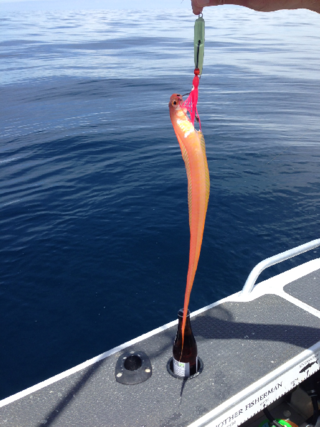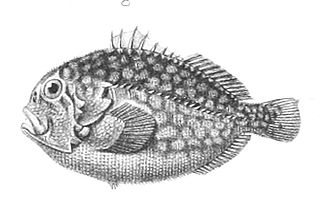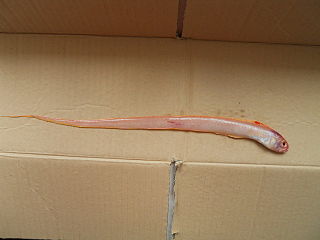
Cepola haastii is a species of marine ray-finned fish belonging to the family Cepolidae, the bandfishes. It is found on the inner continental shelf around New Zealand. Its length is between 15 and 25 cm. This species is known as the red bandfish, a name given to most of the other members of the genus Cepola, especially the European species, Cepola macrophthalma.

Cepolidae is a family of air-breathing land snails, terrestrial pulmonate gastropod mollusks in the superfamily Helicoidea.

Caracanthus, the coral crouchers, or orbicular velvetfishes, are a genus of ray-finned fishes. They live in coral reefs of the tropical Indo-Pacific. This genus is the only member of the monotypic subfamily Caracanthinae, part of the family Scorpaenidae.

Cepola is a genus of marine ray-finned fishes belonging to the bandfish family, Cepolidae. The name red bandfish is applied to all members of this genus, but particularly C. macrophthalma, and generally not C. australis, which is also known as the Australian bandfish.

Cepola macrophthalma is a species of marine ray-finned fish belonging to the family Cepolidae, the bandfishes. It is found in the eastern Atlantic and Mediterranean from Senegal north to the British Isles. This species is known as the red bandfish, though this name is also given to other members of the genus Cepola.
Cepola pauciradiata, the Guinean bandfish, is a species of marine ray-finned fish belonging to the family Cepolidae, the bandfishes.. It is found on the Atlantic coast of Africa.

The black scorpionfish, also known as the European scorpionfish or small-scaled scorpionfish, is a venomous scorpionfish, common in marine subtropical waters. It is widespread in the Eastern Atlantic Ocean from the British Isles to the Azores and Canary Islands, near the coasts of Morocco, in the Mediterranean Sea and the Black Sea.

Platycephaloidei is a suborder of ray-finned fishes, part of the order Scorpaeniformes, and includes the flatheads, ghost flatheads and sea robins.

Choridactylus is a genus of marine ray-finned fishes, it is one of two genera in the tribe Choridactylini, one of the three tribes which are classified within the subfamily Synanceiinae within the family Scorpaenidae, the scorpionfishes and their relatives. They are commonly known as stingfishes. They are found in the Indo-West Pacific.

The marbled spinefish, also known as the yellow waspfish, is a species of ray-finned fish, a waspfish belonging to the subfamily Tetraroginae of the family Scorpaenidae, the scorpionfishes and their relatives. It is the only species in the monotypic genus Cottapistus. This species is found in the Indo-West Pacific.

Paracentropogon is a genus of ray-finned fishes, waspfishes belonging to the subfamily Tetraroginae, which is classified as part of the family Scorpaenidae, the scorpionfishes and their relatives, These fish are found in the Indian Ocean and western Pacific Ocean.

Acanthocepola is a genus of marine ray-finned fishes belonging to the family Cepolidae, the bandfishes. They are native to the Indian Ocean and the western Pacific Ocean.
Owstonia is a genus of marine ray-finned fish belonging to the family Cepolidae, the bandfishes. It is the only genus in the monotypic subfamily Owstoninae. They are found in deep waters of the Indian and Pacific Ocean.
Owstonia taeniosoma is a species of marine ray-finned fish belonging to the family Cepolidae, the bandfishes. It is known from the Indo-West Pacific region.

Branchiostegus is a genus of marine ray-finned fishes, tilefishes belonging to the family Malacanthidae. They are found in the eastern Atlantic Ocean through the Indian Ocean to the western Pacific Ocean. Here they create burrows in soft substrates in the comparatively deep waters of the continental shelf and slope.

The Australian bandfish is a species of bandfish in the family Cepolidae. It has been reported from the Indo-Pacific coastal regions of Australia, New Zealand, and New Caledonia, although some of these records may represent confusion with other species.
Cepola schlegelii i is a species of marine ray-finned fish belonging to the family Cepolidae, the bandfishes. It is found in the Indo-West Pacific region.

Cepolinae is one of two subfamilies of marine ray-finned fish belonging to family Cepolidae, the bandfishes.

Triglinae is a subfamily of demersal, marine ray-finned fishes, part of the family Triglidae, the gurnards and searobins. These gurnards are found in all the tropical and temperate oceans of the world except for the Western Atlantic Ocean.

Stichaeinae is a subfamily of marine ray-finned fishes, classified within the family Stichaeidae, the pricklebacks or shannies. These fishes are found in the North Pacific, Arctic and North Atlantic Oceans.














